Introduction
The Role of Policymakers and Communities in Education is a cornerstone of societal progress and individual development. Its quality and accessibility are critical to shaping the future of communities and nations. However, the responsibility of ensuring a robust educational system does not rest solely on educators. Policymakers and communities play pivotal roles in creating an environment conducive to effective learning and teaching. This article delves into the essential contributions of policymakers and communities in education, highlighting their collaborative efforts and the impact of their involvement.
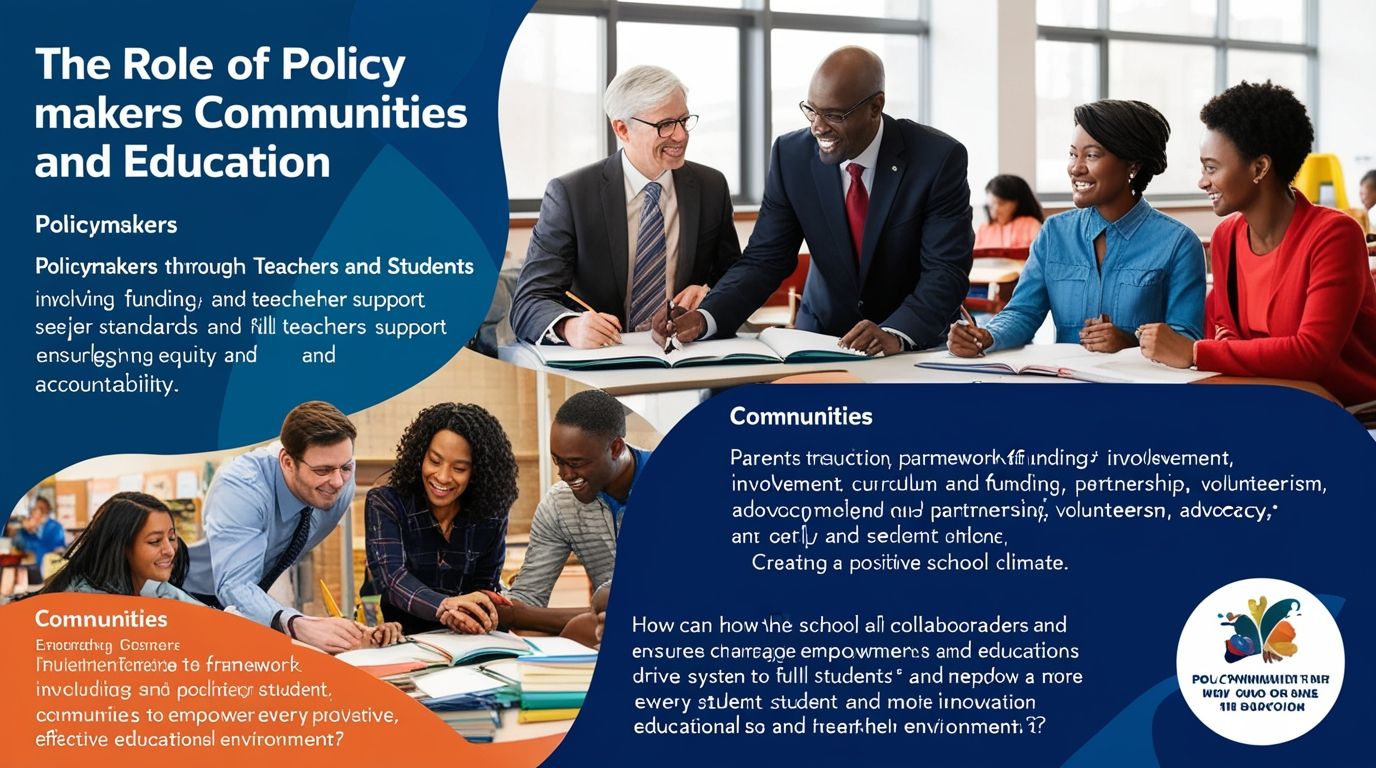
Policymakers in Education: Crafting the Framework
The Role of Policymakers and Communities in Education Policymakers, including government officials, legislators, and education authorities, are instrumental in shaping the educational landscape. Their decisions influence funding, curriculum standards, teacher qualifications, and overall educational policy. Here are some key areas where policymakers make a significant impact:
1. Funding and Resource Allocation
One of the primary roles of policymakers is to allocate sufficient funding for education. This includes not only ensuring that schools have the necessary resources but also addressing disparities in funding between different regions and schools. Adequate funding is essential for hiring qualified teachers, maintaining facilities, providing learning materials, and incorporating technology into classrooms.
2. Curriculum Development and Standards
Policymakers are responsible for setting educational standards and developing curricula that meet the needs of the modern world. This involves determining what subjects and skills students should learn at various stages of their education. A well-designed curriculum prepares students for higher education and the workforce, fostering critical thinking, creativity, and problem-solving skills.
3. Teacher Recruitment and Professional Development
Ensuring that schools have competent and well-trained teachers is a crucial responsibility of policymakers. This includes establishing certification requirements, providing competitive salaries, and creating opportunities for ongoing professional development. Policies that support teacher training and retention help build a stable and skilled workforce, which is essential for delivering quality education.
4. Equity and Inclusion
Policymakers must address issues of equity and inclusion within the education system. This includes creating policies that ensure all students, regardless of their socio-economic background, race, gender, or ability, have access to high-quality education. This might involve implementing programs to support disadvantaged students, providing special education services, and promoting inclusive practices in schools.The Role of Policymakers and Communities in Education very much vital in equity and inclusion.
5. Accountability and Assessment
Policymakers play a role in establishing systems of accountability to ensure that schools and educators are meeting educational standards. This often involves standardized testing and other forms of assessment to monitor student progress and school performance. However, it is important for policymakers to balance accountability with support, ensuring that assessments are used to improve education rather than merely punish underperformance.
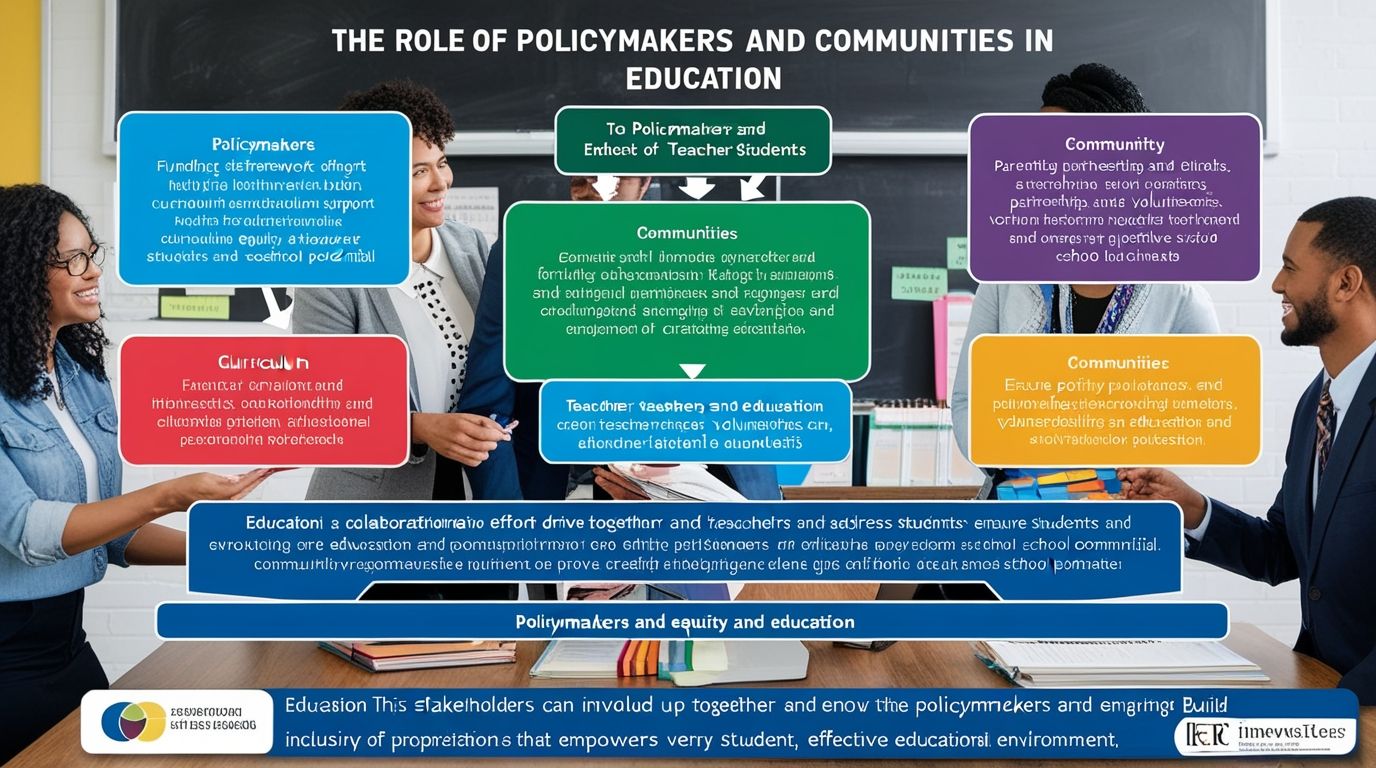
The Role of Communities in Education: Building a Supportive Network
Communities, encompassing parents, local organizations, businesses, and other stakeholders, are vital to the educational ecosystem. Their involvement can enhance the educational experience for students and support schools in numerous ways. Here are key aspects of community involvement in education:
1. Parental Engagement
Parents are a child’s first teachers, and their involvement in education continues to be crucial throughout their school years. Parental engagement can take many forms, including helping with homework, attending parent-teacher conferences, volunteering at schools, and participating in school governance. When parents are actively involved, students are more likely to succeed academically and develop positive attitudes toward learning.
2. Community Partnerships
Local businesses, non-profits, and other community organizations can partner with schools to provide resources, expertise, and opportunities for students. These partnerships might include internships, mentoring programs, educational workshops, and extracurricular activities. By leveraging the strengths of the community, schools can offer students a richer and more diverse educational experience.
3. Volunteerism
Community members can volunteer their time and skills to support schools in various capacities. This might involve tutoring students, assisting with school events, or providing professional expertise for school projects. Volunteers can help alleviate some of the burdens on teachers and staff, allowing them to focus more on instruction and student support.
4. Advocacy and Support
Communities can advocate for better educational policies and funding at the local, state, and national levels. This involves organizing and participating in campaigns, attending school board meetings, and working with policymakers to promote positive changes in education. Community support can be a powerful force in driving educational reform and ensuring that schools receive the resources they need.
5. Creating a Positive School Climate
A supportive and positive school climate is essential for student success. Communities can contribute to creating such an environment by promoting respect, inclusivity, and safety within schools. This involves addressing issues such as bullying, discrimination, and mental health, and fostering a culture of kindness and mutual respect.
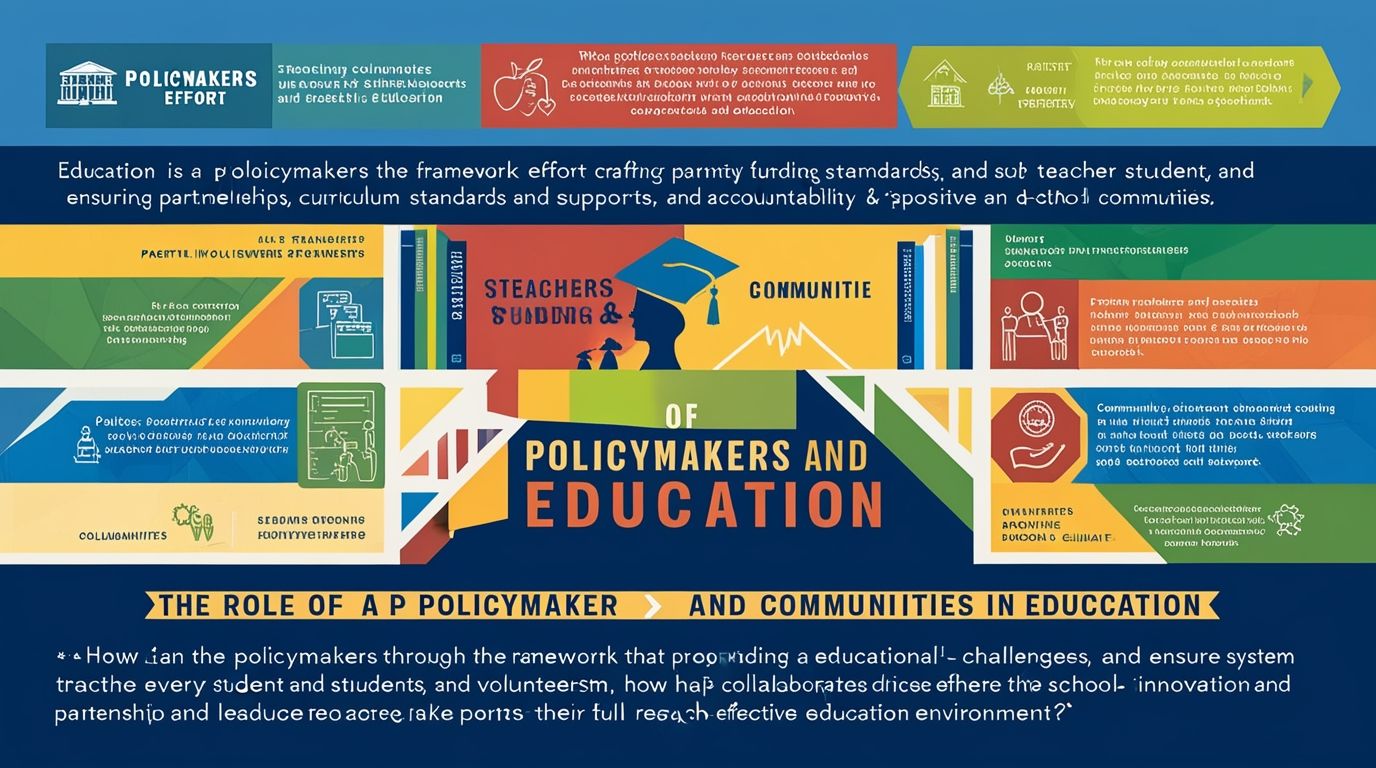
Collaborative Efforts: Policymakers and Communities Working Together
While policymakers and communities have distinct roles in education, their efforts are most effective when they work collaboratively. Here are some ways in which policymakers and communities can join forces to improve education:
1. Communication and Transparency
Effective collaboration requires open communication and transparency between policymakers and communities. Policymakers should engage with community members, listen to their concerns and ideas, and keep them informed about policy decisions and their implications. Regular forums, town hall meetings, and advisory councils can facilitate this dialogue and ensure that community voices are heard.
2. Shared Goals and Vision
Policymakers and communities should work together to develop a shared vision for education that reflects the needs and aspirations of all stakeholders. This involves setting common goals, identifying priorities, and developing strategies to achieve them. By aligning their efforts, policymakers and communities can create a more cohesive and effective educational system.
3. Leveraging Resources
Communities often have resources that can complement those provided by policymakers. By working together, they can maximize these resources to benefit schools and students. For example, local businesses might provide funding for school programs, while community organizations could offer specialized services such as counseling or after-school activities.
4. Innovative Solutions
Collaboration between policymakers and communities can lead to innovative solutions to educational challenges. For instance, community input can inspire new approaches to curriculum design, while policy support can enable the implementation of cutting-edge technologies in classrooms. By fostering a culture of innovation, stakeholders can create more dynamic and effective educational environments.
5. Monitoring and Evaluation
Ongoing monitoring and evaluation are crucial for assessing the impact of educational policies and initiatives. Policymakers and communities should work together to track progress, identify areas for improvement, and make necessary adjustments. This collaborative approach ensures that policies remain responsive to the needs of students and schools.
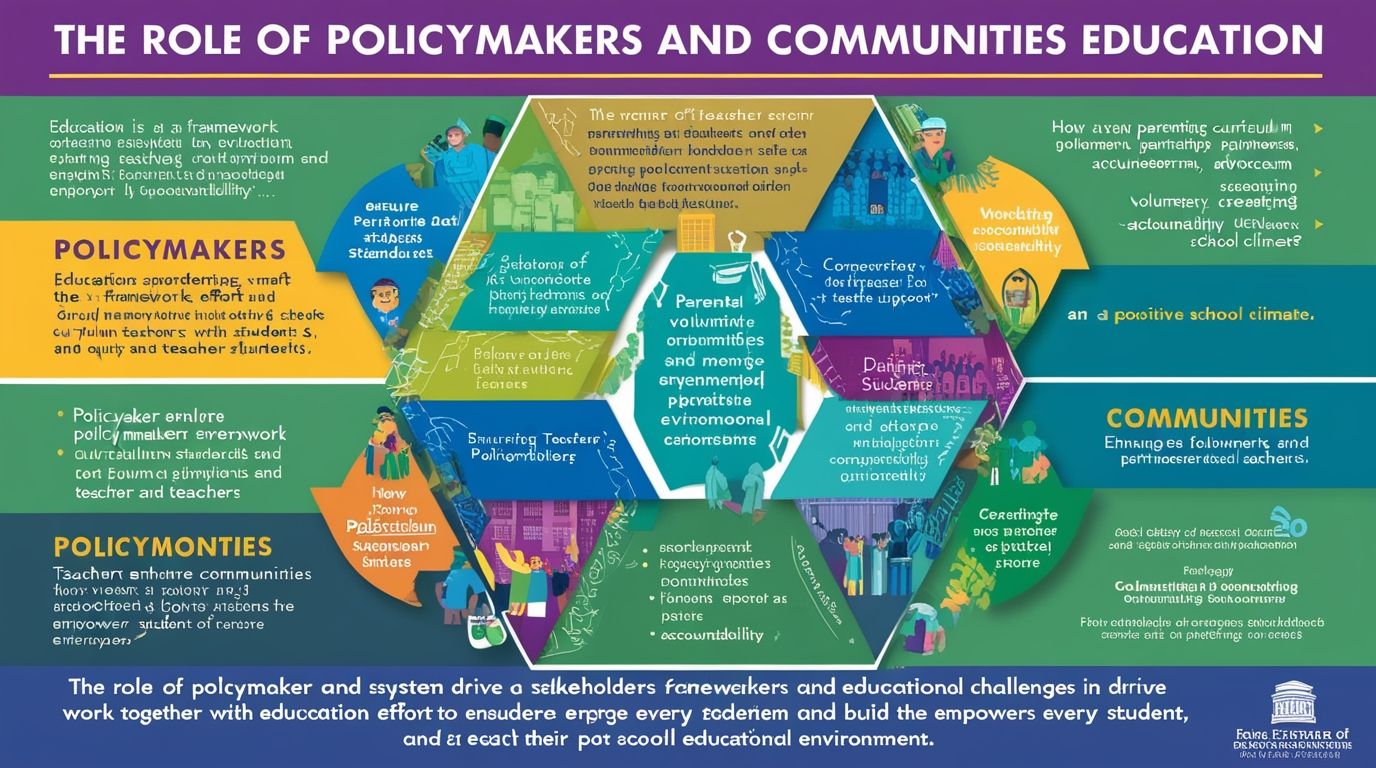
Case Studies: Successful Collaborations
Several examples from around the world highlight the positive impact of collaboration between policymakers and communities in education:
1. Community Schools in the United States
Community schools in the U.S. are a model of successful collaboration. These schools partner with local organizations to provide a range of services, including healthcare, counseling, and after-school programs. By addressing the holistic needs of students, community schools have improved academic outcomes and strengthened community ties.
2. Finland’s Education System
Finland’s education system is renowned for its success, partly due to the close collaboration between policymakers, educators, and communities. Policymakers in Finland prioritize teacher autonomy and professional development, while communities support schools through active engagement and local initiatives. This collaborative approach has resulted in high educational performance and student well-being.
3. Singapore’s Public-Private Partnerships
Singapore’s education system benefits from strong public-private partnerships. Policymakers work with businesses and community organizations to provide students with opportunities for real-world learning and career preparation. These partnerships have helped Singapore develop a highly skilled workforce and maintain a competitive edge in the global economy.
Conclusion
The roles of policymakers and communities in education are interconnected and complementary. Policymakers provide the framework and resources necessary for a functioning educational system, while communities offer support, engagement, and advocacy to enhance the learning experience. Together, they can create an environment that fosters academic excellence, equity, and holistic development.
The Role of Policymakers and Communities in Education embracing collaboration and leveraging their respective strengths, policymakers and communities can address the challenges facing education and work towards a shared vision of a brighter future for all students. This collaborative effort is essential for building an educational system that not only meets the demands of the 21st century but also empowers every student to reach their full potential.
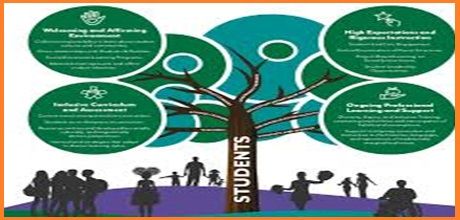
cxj135
qbuf51
gqeqki
Some genuinely interesting information, well written and loosely user friendly.
ztu9et
rwt7oj
Hello! I just would like to give a huge thumbs up for the great info you have here on this post. I will be coming back to your blog for more soon.
fantástico este conteúdo. Gostei muito. Aproveitem e vejam este site. informações, novidades e muito mais. Não deixem de acessar para descobrir mais. Obrigado a todos e até mais. 🙂
Really enjoyed this post, can you make it so I receive an email sent to me whenever you write a fresh update?
Hello.This post was really remarkable, especially because I was searching for thoughts on this matter last week.
Very nice post and right to the point. I am not sure if this is really the best place to ask but do you folks have any thoughts on where to employ some professional writers? Thank you 🙂
When I initially commented I clicked the “Notify me when new comments are added” checkbox and now each time a comment is added I get three emails with the same comment. Is there any way you can remove people from that service? Thanks a lot!
I’m not sure where you’re getting your information, but great topic. I needs to spend some time learning more or understanding more. Thanks for wonderful information I was looking for this info for my mission.
Great post, you have pointed out some good points, I as well think this s a very great website.
This is really interesting, You are a very skilled blogger. I’ve joined your feed and look forward to seeking more of your magnificent post. Also, I have shared your site in my social networks!
I’ve been browsing online greater than 3 hours as of late, yet I by no means found any interesting article like yours. It’s beautiful price enough for me. Personally, if all webmasters and bloggers made just right content material as you did, the net can be much more helpful than ever before.
you have a great blog here! would you like to make some invite posts on my blog?
Very useful tips! I’m excited to implement them soon.
Your advice is exactly what I needed right now.
**mind vault**
mind vault is a premium cognitive support formula created for adults 45+. It’s thoughtfully designed to help maintain clear thinking
**sugarmute**
sugarmute is a science-guided nutritional supplement created to help maintain balanced blood sugar while supporting steady energy and mental clarity.
**glpro**
glpro is a natural dietary supplement designed to promote balanced blood sugar levels and curb sugar cravings.
**breathe**
breathe is a plant-powered tincture crafted to promote lung performance and enhance your breathing quality.
**potentstream**
potentstream is engineered to promote prostate well-being by counteracting the residue that can build up from hard-water minerals within the urinary tract.
h41pnk
This is the right blog for anyone who wants to find out about this topic. You realize so much its almost hard to argue with you (not that I actually would want…HaHa). You definitely put a new spin on a topic thats been written about for years. Great stuff, just great!
**memory lift**
memory lift is an innovative dietary formula designed to naturally nurture brain wellness and sharpen cognitive performance.
Thanks for the sensible critique. Me and my neighbor were just preparing to do some research about this. We got a grab a book from our local library but I think I learned more clear from this post. I’m very glad to see such excellent info being shared freely out there.